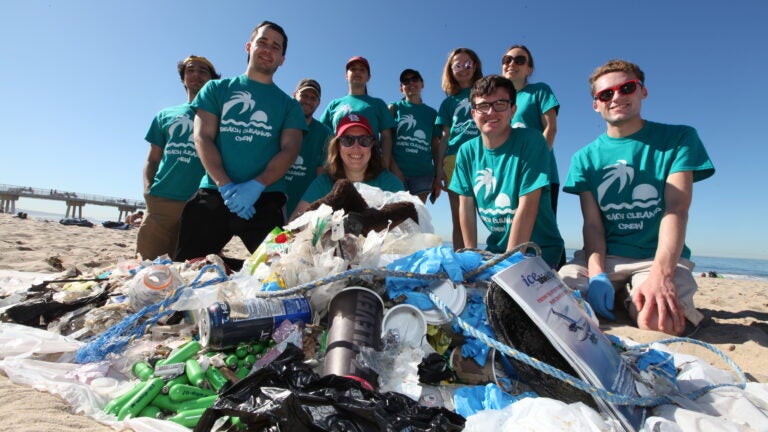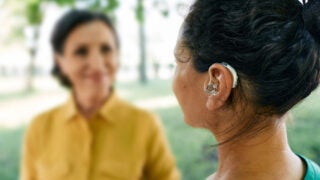
5 ways USC researchers are working to reduce waste
EARTH WEEK: University scientists and engineers aim to replace plastics and batteries with more sustainable, degradable resources for the future.
Scientists and engineers at USC are confronting pollution with innovation. From chemists to materials engineers, USC faculty are concerned about the accumulating waste — much of it non-biodegradable. They are developing their own biodegradable replacement materials to end global dependency on plastic and come up with better, more sustainable alternatives for batteries and solar cells.
1. Make solar energy storage more efficient
For skyscrapers in the urban core, achieving zero carbon is a nearly impossible task with current silicon solar technology. The limited footprint atop these structures doesn’t offer enough room to put on solar panels that will generate sufficient power. According to USC Dornsife College of Letters, Arts and Sciences chemist Mark E. Thompson, covering the sides of the buildings could produce enough electricity, but silicon has a major drawback: It can’t be made transparent and would prevent natural light from entering. However, Thompson is working on a cutting-edge organic-based solar cell that might solve the problem.
“A good silicon solar cell is 20% efficient — 20% of the light hitting it is converted to electrical energy,” Thompson said. “It also absorbs visible light, but it doesn’t absorb much infrared. With organic-based solar cells, we can design them to absorb strongly in the near infrared where there’s plenty of light that you can’t see.”
Thompson’s group designs organic molecules for this application, and they’re working with collaborators at the University of Michigan who have developed a solar cell window coating that is 50% transparent and is still 10% efficient. “It is a promising solution to achieve zero carbon,” he said.
2. Find opportunities to ‘upcycle’ and reuse plastics in novel ways
What if we could get away from traditional construction materials entirely? Qiming Wang, assistant professor of civil and environmental engineering at the USC Viterbi School of Engineering, develops bio-inspired materials that can react to damage and actually heal. Developing new eco-friendly materials will reduce the negative environmental impacts tied to construction, Wang said, noting that existing cement-based construction materials contribute 8% to 10% of global carbon dioxide emissions.
“Resilience and sustainability are two of the great challenges facing human society,” Wang said. “How do we manufacture new structures that can better resist and heal damage after extreme events? How do we design next-generation infrastructure that will be strengthened by harnessing carbon dioxide, but not weakened by greenhouse gases?”
Using state-of-the-art manufacturing methods, Wang’s research group fabricates materials that mimic the microstructures and functions of natural structures.
“One place this technology might soon be available to consumers will be upcycling plastic waste into useful materials, such as furniture and construction materials,” he said. “Another near-future technology will be negative-carbon emission construction materials. Developing new materials that can better resist and heal damages after extreme events will reduce negative environmental impacts — as well as the costs of replacing or repairing infrastructure.”
3. Fuel the ‘hydrogen highway’
The promise of cars fueled by hydrogen is enticing: zero greenhouse emissions with water as the sole byproduct. However, a lack of infrastructure has limited wide-scale adoption of this alternative fuel source. One major challenge in California is the lack of hydrogen available between Los Angeles and San Francisco, according to USC Dornsife chemist Travis Williams. He is developing new technology to store hydrogen that might overcome this barrier.
“In California, we’ve talked about the ‘hydrogen highway’ — what if you wanted to drive your car from L.A. to San Francisco in a hydrogen fuel cell vehicle … could you fill it?” Williams asked. “There’s hydrogen in Bakersfield, but there’s a dead zone all the way from there to the South Bay.”
Williams says the key to storing hydrogen in a liquid carrier, and the releasing hydrogen on-site, might be catalysis. “Researchers at the Department of Energy think what we can do is take some liquid, hydrogenate it catalytically somewhere that’s hydrogen-rich, and then dehydrogenate it later where you need it, like a remote filling station,” he said. “We’ve got a demo fuel unit which we are developing — you could probably fill a little golf cart with it, but the proof of concept is there.”
4. Make processing for plastics safer to eliminate toxic byproducts
Creating new plastics — and destroying old ones — drives the research of Megan Fieser, Gabilan Assistant Professor of Chemistry at USC Dornsife. She is unlocking safe, environmentally friendly ways to break down plastics and other non-biodegradable materials using catalysts. Motivated by the destructive accumulation of plastics in the oceans, she is seeking ways to reduce their harmful impact.
“Plastics are very difficult to degrade,” Fieser said. “PVC, in particular, tends to release hydrochloric acid and other toxic products, whether it’s in the landfill or people try to recycle it. There are also a lot of plastics that have things that stay inside. For instance, BPA in polycarbonate plastics was a big craze a few years ago where everybody was very worried. That’s an example of a building block of plastic being left behind in those plastics.”
Fieser’s research group seeks to make processing of PVC in recycling centers more environmentally friendly. “Utilizing catalysis, we chop up those plastics into small molecules or new plastics,” she said. “Not only can we successfully recycle these plastics, but we can potentially create the plastic into a higher value product.”
5. How you can help: Reduce your use of plastics
Microplastics have emerged as a concerning pollutant of coastal California waters. USC Dornsife environmental scientist Jill Sohm said plastics less than 5 millimeters in size are ubiquitous — particles from tires, microfibers from synthetic fabrics and breakdown products from larger plastic litter are a few examples. We’re beginning to understand their impacts, but research is still in the early stages. While the research matures, Sohm noted that reducing the amount of plastic products you purchase will make an immediate impact.
“The best way to reduce the impact of plastics in L.A.’s waters is to prevent the use of plastics in the first place,” she said. “Choose non-plastic alternatives like aluminum cans or bring your own utensils instead of taking single-use options at restaurants. … Choose clothing made with natural fibers when possible. This problem will also require larger scale changes only possible through new policies and regulations, so lobbying your representatives to support plastic source reduction legislation is key.”



